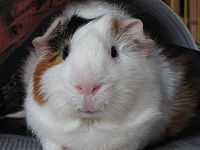Gene project

Welcome to the Wikiversity Gene project.
Summary
Participants in this project explore genes, or specific isoforms.
Learning materials
Learning materials and learning projects are located in the main Wikiversity namespace. Simply make a link to the name of the resource (resources are independent pages in the main namespace) and start writing!
You should also read about the Wikiversity:Learning model. Resources should center on learning activities for Wikiversity participants. Learning materials and learning projects can be used by multiple projects. Cooperate with other departments that use the same learning resource.
Texts
A search on the full web or at Wikibooks will provide you with quite a variety of texts on genes.
Activities
- Go to Genes. Enter a number from 1 to 100,534,000 followed by [uid] and a common name for your organism of interest, e.g., "human", without the quotes if one word or with the quotes, e.g., "Eastern chipmunk", if two or more. If the number you've chosen does not contain a gene for your organism, try entering only the common name for the organism. Some genes have multiple isoforms coming from the same gene locus. Pick one or all, as you wish.
- Feel free to compose an activity! Be bold!
Readings
At the bottom of this project resource is a template entitled "Gene project", which contains lectures, articles, activities, quizzes and other readings and activities.
Active participants
- --Marshallsumter (discuss • contribs) 21:14, 27 June 2014 (UTC)
Learning project summary
- Project code:
- Suggested Prerequisites:
- ...
- Time investment:
- Assessment suggestions:
- Portal:
- School:
- Department:
- Stream
- Level:
Original research project summary
- Portal:Life Sciences portal
- School:Biology
- Division:Genetics
A1BG
- 1[uid]
- Transcription of A1BG
Research
Hypothesis:
- The transcription mechanism for A1BG can be found.
Control groups

The findings demonstrate a statistically systematic change from the status quo or the control group.
“In the design of experiments, treatments [or special properties or characteristics] are applied to [or observed in] experimental units in the treatment group(s).[1] In comparative experiments, members of the complementary group, the control group, receive either no treatment or a standard treatment.[2]"[3]
Proof of concept
Def. a “short and/or incomplete realization of a certain method or idea to demonstrate its feasibility"[4] is called a proof of concept.
Def. evidence that demonstrates that a concept is possible is called proof of concept.
The proof-of-concept structure consists of
- background,
- procedures,
- findings, and
- interpretation.[5]
See also
References
- ↑ Klaus Hinkelmann, Oscar Kempthorne (2008). Design and Analysis of Experiments, Volume I: Introduction to Experimental Design (2nd ed.). Wiley. ISBN 978-0-471-72756-9. http://books.google.com/?id=T3wWj2kVYZgC&printsec=frontcover.
- ↑ R. A. Bailey (2008). Design of comparative experiments. Cambridge University Press. ISBN 978-0-521-68357-9. http://www.cambridge.org/uk/catalogue/catalogue.asp?isbn=9780521683579.
- ↑ "Treatment and control groups, In: Wikipedia". San Francisco, California: Wikimedia Foundation, Inc. May 18, 2012. Retrieved 2012-05-31.
- ↑ "proof of concept, In: Wiktionary". San Francisco, California: Wikimedia Foundation, Inc. November 10, 2012. Retrieved 2013-01-13.
- ↑ Ginger Lehrman and Ian B Hogue, Sarah Palmer, Cheryl Jennings, Celsa A Spina, Ann Wiegand, Alan L Landay, Robert W Coombs, Douglas D Richman, John W Mellors, John M Coffin, Ronald J Bosch, David M Margolis (August 13, 2005). "Depletion of latent HIV-1 infection in vivo: a proof-of-concept study". Lancet 366 (9485): 549-55. doi:10.1016/S0140-6736(05)67098-5. http://www.ncbi.nlm.nih.gov/pmc/articles/PMC1894952/. Retrieved 2012-05-09.
External links
- African Journals Online
- Bing Advanced search
- GenomeNet KEGG database
- Google Books
- Google scholar Advanced Scholar Search
- Home - Gene - NCBI
- JSTOR
- Lycos search
- NASA's National Space Science Data Center
- NCBI All Databases Search
- Office of Scientific & Technical Information
- PubChem Public Chemical Database
- Questia - The Online Library of Books and Journals
- SAGE journals online
- Scirus for scientific information only advanced search
- SpringerLink
- Taylor & Francis Online
- WikiDoc The Living Textbook of Medicine
- Wiley Online Library Advanced Search
- Yahoo Advanced Web Search
| |||||||||||||||||||||||||||||||||||||||||
| |||||||||||||||||||||||||||||||||||
![]() This is a research project at http://en.wikiversity.org
This is a research project at http://en.wikiversity.org
| |
Development status: this resource is experimental in nature. |
| |
Educational level: this is a research resource. |
| |
Subject classification: this is a genetics resource. |